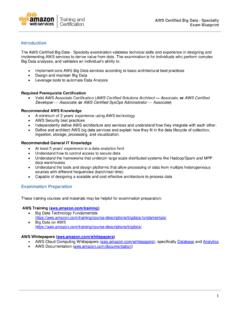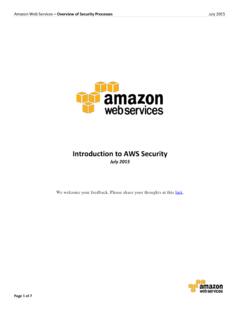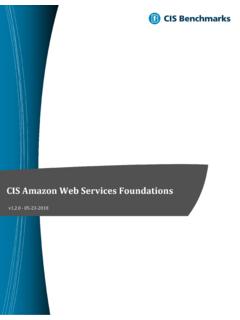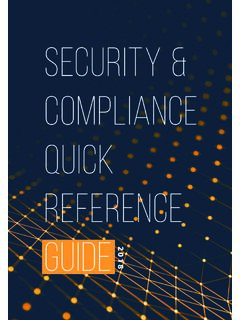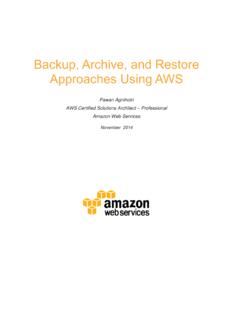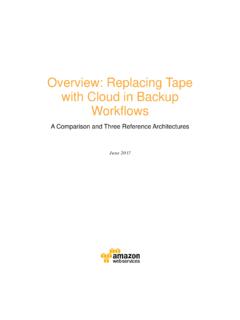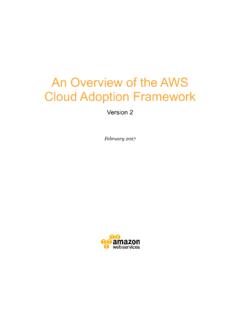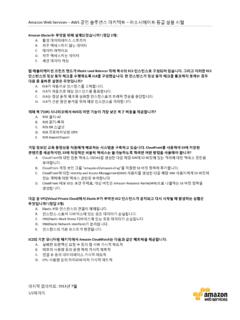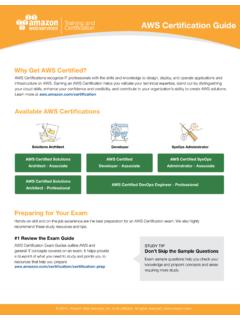Transcription of ITIL Asset and Configuration Management in the Cloud
1 ITIL Asset and Configuration Management in the Cloud January 2017. 2017, Amazon Web Services, Inc. or its affiliates. All rights reserved. Notices This document is provided for informational purposes only. It represents AWS's current product offerings and practices as of the date of issue of this document, which are subject to change without notice. Customers are responsible for making their own independent assessment of the information in this document and any use of AWS's products or services, each of which is provided as is . without warranty of any kind, whether express or implied. This document does not create any warranties, representations, contractual commitments, conditions or assurances from AWS, its affiliates, suppliers or licensors. The responsibilities and liabilities of AWS to its customers are controlled by AWS. agreements, and this document is not part of, nor does it modify, any agreement between AWS and its customers. Contents Introduction 1.
2 What Is ITIL? 1. AWS Cloud Adoption Framework 2. Asset and Configuration Management in the Cloud 3. Asset and Configuration Management and AWS CAF 5. Impact on Financial Management 5. Creating a Configuration Management Database 6. Managing the Configuration Lifecycle in the Cloud 8. Conclusion 9. Contributors 10. Abstract Cloud initiatives require more than just the right technology. They also must be supported by organizational changes, such as people and process changes. This paper is intended for IT service Management (ITSM) professionals who are supporting a hybrid Cloud environment that leverages AWS. It outlines best practices for Asset and Configuration Management , a key area in the IT. Infrastructure Library (ITIL), on the AWS Cloud platform. Amazon Web Services ITIL Asset and Configuration Management in the Cloud Introduction Leveraging the experiences of enterprise customers who have successfully integrated their Cloud strategy with their IT Infrastructure Library (ITIL)-based service Management practices, this paper will cover: Asset and Configuration Management in ITIL.
3 AWS Cloud Adoption Framework (AWS CAF). Cloud -specific Asset and Configuration Management best practices like creating a Configuration Management database What Is ITIL? The framework managed by AXELOS Limited defines a commonly used, best practice approach to IT service Management (ITSM). Although it builds on ISO/IEC 20000, which provides a formal and universal standard for organizations seeking to have their ITSM capabilities audited and certified, 1. ITIL goes one step further to propose operational processes required to deliver the standard. ITIL is composed of five volumes that describe the ITSM lifecycle, as defined by AXELOS: Service Strategy Understands organizational objectives and customer needs. Service Design Turns the service strategy into a plan for delivering the business objectives. Service Transition Develops and improves capabilities for introducing new services into supported environments. Service Operation Manages services in supported environments.
4 Continual Service Achieves incremental and large-scale improvements to services. Improvement Each volume addresses the capabilities that enterprises must have in place. Asset and Configuration Management is one of the chapters in the Service Transition volume. For more information, see the Axelos Page 1. Amazon Web Services ITIL Asset and Configuration Management in the Cloud AWS Cloud Adoption Framework AWS CAF is used to help enterprises modernize ITSM practices so that they can take advantage of the agility, security, and cost benefits afforded by public or hybrid clouds. ITIL and AWS CAF are compatible. Like ITIL, AWS CAF organizes and describes all of the activities and processes involved in planning, creating, managing, and supporting modern IT services. It offers practical guidance and comprehensive guidelines for establishing, developing, and running Cloud - based IT capabilities. AWS CAF is built on seven perspectives: People Selecting and training IT personnel with appropriate skills, defining and empowering delivery teams with accountabilities and service- level agreements.
5 Process Managing programs and projects to be on time, on target, and within budget while keeping risks at acceptable levels. Security Applying a comprehensive and rigorous method for describing the structure and behavior for an organization's security processes, systems, and personnel. Business Identifying, analyzing, and measuring the effectiveness of IT. investments. Maturity Analyzing, defining, and anticipating demand for and acceptance of planned IT capabilities and services. Platform Defining and describing core architectural principles, standards, and patterns that are required for optimal IT capabilities and services. Operations Transitioning, operating, and optimizing the hybrid IT environment, enabling efficient and automated IT service Management . AWS CAF is an important supplement to enterprise ITSM frameworks used today because it provides enterprises with practical operational advice for implementing and operating ITSM in a Cloud -based IT infrastructure.
6 For more information, see AWS Cloud Adoption Page 2. Amazon Web Services ITIL Asset and Configuration Management in the Cloud Asset and Configuration Management in the Cloud In practice, Asset and Configuration Management aligns very closely to other ITIL processes, such as incident Management , change Management , problem Management , or service-level Management . ITIL defines an Asset as any resource or capability that could contribute to the delivery of a service.. Examples of assets include: virtual or physical storage virtual or physical servers a software license undocumented information known to internal team members ITIL defines Configuration items as an Asset that needs to be managed in order to deliver an IT service. All Configuration items are assets, but many assets are not Configuration items. Examples of Configuration items include a virtual or physical server or a software license. Every Configuration item should be under the control of change Management .
7 The goals of Asset and Configuration Management are to: Support ITIL processes by providing accurate Configuration information to assist decision making (for example, the authorization of changes, the planning of releases) and to help resolve incidents and problems faster. Minimize the number of quality and compliance issues caused by incorrect or inaccurate Configuration of services and assets. Define and control the components of services and infrastructure and maintain accurate Configuration information on the historical, planned, and current state of the services and infrastructure. The value to business is: Page 3. Amazon Web Services ITIL Asset and Configuration Management in the Cloud Optimization of the performance of assets improves the performance of the service overall. For example, it mitigates risks caused by service outages and failed licensing audits. Asset and Configuration Management provides an accurate representation of a service, release, or environment, which enables: o Better planning of changes and releases.
8 O Improved incident and problem resolution. o Meeting service levels and warranties. o Better adherence to standards and legal and regulatory obligations (fewer non-conformances). o Traceable changes. o The ability to identify the costs for a service. The following diagram from AXELOS shows there are elements in Asset and Configuration Management that directly relate to elements in change Management . Asset and Configuration Management underpins change Management . Without it, the business is subject to increased risk and uncertainty. Figure 1: Asset and Configuration Management in ITIL. Page 4. Amazon Web Services ITIL Asset and Configuration Management in the Cloud Asset and Configuration Management and AWS CAF. As with most specifications covered in the Service Transition volume of ITIL, Asset and Configuration Management falls into the Cloud Service Management function of the AWS CAF Operations perspective. People and process changes should be supported by a Cloud governance forum or Center of Excellence whose role is to use AWS CAF to manage through the transition.
9 From the perspective of ITSM, your operations should certainly have a seat at the table. As shown in Figure 2, AWS CAF accounts for the Management of assets and Configuration items in a hybrid environment. Information can come from the on-premises environment or any number of Cloud providers (private or public). Figure 2: AWS CAF integration Impact on Financial Management One of the most important aspects of Asset Management is to ensure data is available for these financial Management processes: Capitalization and depreciation Software license Management Page 5. Amazon Web Services ITIL Asset and Configuration Management in the Cloud Compliance requirements These activities typically require comprehensive Asset lifecycle Management processes, which take significant cost and effort. One of the benefits of moving IT to the Cloud is that the financial nature of the transaction moves from a capital expenditure (CAPEX) to an operating expenditure (OPEX).
10 You can do away with the large capital outlays (for example, a server refresh) that require months of planning as well as amortization and depreciation. Creating a Configuration Management Database A Configuration Management database (CMDB) is used by IT to track and manage its resources. The CMDB presents a logical model of the enterprise infrastructure to give IT more control over the environment and facilitate decision-making. At a minimum, a CMDB contains the following: Configuration item (CI) records with all associated attributes captured. A relationship model between different CIs. A history of all service impacts in the form of incidents, changes, and problems. In a traditional IT setup, the goals of establishing a CMDB are met through the process of: Discovery tools used to create a record of existing CIs. Comprehensive change Management processes to keep track of creation and updates to CIs. Integration of incident and problem Management data with impacted CIs with ITSM workflow tools like BMC, Hewlett-Packard, or ServiceNow.
